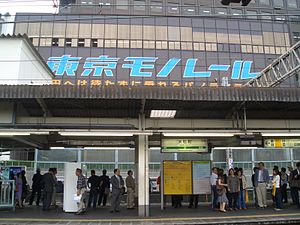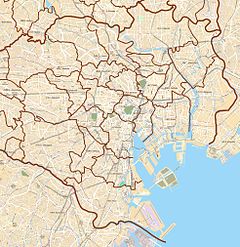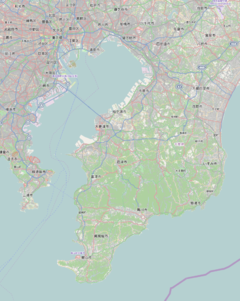35°39′19″N 139°45′27″E / 35.655230°N 139.757627°E
HMCJK23JY28 MO01 Hamamatsuchō Station 浜松町駅 | ||||||||||||||||||||||||||||||||||
|---|---|---|---|---|---|---|---|---|---|---|---|---|---|---|---|---|---|---|---|---|---|---|---|---|---|---|---|---|---|---|---|---|---|---|
 Hamamatsucho Station | ||||||||||||||||||||||||||||||||||
| General information | ||||||||||||||||||||||||||||||||||
| Location | 1-3-1 Kaigan District, Minato City, Tokyo Japan | |||||||||||||||||||||||||||||||||
| Operated by | ||||||||||||||||||||||||||||||||||
| Line(s) |
| |||||||||||||||||||||||||||||||||
| Construction | ||||||||||||||||||||||||||||||||||
| Structure type | Ground Level (Keihin-Tōhoku and Yamanote Lines) Elevated (Tokyo Monorail) | |||||||||||||||||||||||||||||||||
| Other information | ||||||||||||||||||||||||||||||||||
| Station code |
| |||||||||||||||||||||||||||||||||
| History | ||||||||||||||||||||||||||||||||||
| Opened | 16 December 1909 | |||||||||||||||||||||||||||||||||
| Passengers | ||||||||||||||||||||||||||||||||||
| JR East, FY2013 | 155,784 daily | |||||||||||||||||||||||||||||||||
| Services | ||||||||||||||||||||||||||||||||||
| ||||||||||||||||||||||||||||||||||
| ||||||||||||||||||||||||||||||||||
Hamamatsuchō Station (浜松町駅, Hamamatsuchō-eki) is a railway station in Hamamatsuchō, Minato, Tokyo, Japan, operated by East Japan Railway Company (JR East) and Tokyo Monorail.
Lines
editHamamatsuchō Station is served by two JR East lines: the circular Yamanote Line and the Keihin-Tōhoku Line. All trains on these lines stop at Hamamatsuchō.
It is also the terminus of the Tokyo Monorail line to Haneda Airport. The official name of the monorail station is Monorail Hamamatsuchō Station (モノレール浜松町駅, Monorēru-Hamamatsuchō-eki).
Station layout
editJR East
editThe JR East station consists of two platforms serving four tracks, with cross-platform interchange in the direction of travel between the Yamanote line (tracks 2 and 3) and the Keihin-Tōhoku line (tracks 1 and 4).
| 1 | JK Keihin-Tōhoku Line | for Tokyo, Ueno, and Ōmiya |
| 2 | JY Yamanote Line | for Tokyo and Ueno |
| 3 | JY Yamanote Line | for Shinagawa and Shibuya |
| 4 | JK Keihin-Tōhoku Line | for Shinagawa, Yokohama, and Ōfuna |
Tokyo Monorail
editThe Tokyo Monorail platforms are located to the west of the JR station in a separate elevated structure. Two side platforms serve a single track, with one platform used for boarding passengers, and the other platform used for alighting passengers.
Japan's domestic airlines (JAL, ANA, Skymark Airlines, and Air Do) operate check in services for domestic flights from Haneda airport along with ticketing facilities just outside the main Monorail entrances.
-
Monorail Hamamatsucho's Central gate, June 2016
-
The Tokyo Monorail platforms, June 2016
Facilities
edit- Japan Airlines at one time operated a domestic flights only ticketing facility on the third floor of the station.[1]
History
editThe JR station opened on December 16, 1909, as an intermediate station on the newly opened Shinagawa to Karasumori section of the Japanese National Railways.
The Tokyo Monorail station opened on September 17, 1964.[2]
Passenger statistics
editIn fiscal 2013, the JR East station was used by an average of 155,784 passengers daily (boarding passengers only), making it the sixteenth-busiest station operated by JR East.[3] Over the same fiscal year, the Tokyo Monorail station was used by an average of 108,080 passengers daily (exiting and entering passengers), making it the busiest station operated by Tokyo Monorail.[4]
The passenger figures for the JR East station (boarding passengers only) for previous years are as shown below.
| Fiscal year | Daily average |
|---|---|
| 2000 | 152,620[5] |
| 2005 | 144,085[6] |
| 2010 | 153,594[7] |
| 2011 | 151,480[8] |
| 2012 | 153,104[9] |
| 2013 | 155,784[3] |
Surrounding area
edit- Daimon Station, served by the Toei Ōedo Line and the Toei Asakusa Line, is within easy walking distance, although some route maps do not mark them as an interchange. The 1-minute walk is fully signed and easy to locate. When arriving on a train from south, train cars at the front of the train are closest to the exit to Daimon station.[10]
- The station is partially under and directly connected to the World Trade Center (Tokyo).
- Acty Shiodome, the fourth tallest residential building in Japan is a 3-minute walk to the north.[11]
- Hamarikyu Gardens - 1/2 mile north-east
- Kyu Shiba Rikyu Garden - 1/8 mile east
- Shiodome City Center Shopping Mall - 10-minute walk[12]
- Tsukiji Fish Market - 15-minute walk
- Hato Bus Tour terminal[13]
See also
editReferences
edit- ^ "JAL Group Offices Information." Japan Airlines. March 28, 2009. Retrieved on July 21, 2011. "3rd floor, Tokyo mono-rail Hamamatsu-cho Station, 2-4-12 Hamamatsu-Cho Minato-ku, 105-0013"
- ^ Terada, Hirokazu (January 19, 2013). データブック日本の私鉄 [Databook: Japan's Private Railways]. Japan: Neko Publishing. p. 213. ISBN 978-4-7770-1336-4.
- ^ a b 各駅の乗車人員 (2013年度) [Station passenger figures (Fiscal 2013)] (in Japanese). Japan: East Japan Railway Company. Archived from the original on May 6, 2001. Retrieved September 2, 2014.
- ^ 会社概要 [Summary of Company] (in Japanese). Japan: Tokyo Monorail. Retrieved September 2, 2014.
- ^ 各駅の乗車人員 (2000年度) [Station passenger figures (Fiscal 2000)] (in Japanese). Japan: East Japan Railway Company. Archived from the original on October 9, 2014. Retrieved September 2, 2014.
- ^ 各駅の乗車人員 (2005年度) [Station passenger figures (Fiscal 2005)] (in Japanese). Japan: East Japan Railway Company. Archived from the original on October 9, 2014. Retrieved September 2, 2014.
- ^ 各駅の乗車人員 (2010年度) [Station passenger figures (Fiscal 2010)] (in Japanese). Japan: East Japan Railway Company. Archived from the original on October 6, 2014. Retrieved September 2, 2014.
- ^ 各駅の乗車人員 (2011年度) [Station passenger figures (Fiscal 2011)] (in Japanese). Japan: East Japan Railway Company. Archived from the original on October 8, 2014. Retrieved September 2, 2014.
- ^ 各駅の乗車人員 (2012年度) [Station passenger figures (Fiscal 2012)] (in Japanese). Japan: East Japan Railway Company. Archived from the original on October 7, 2014. Retrieved September 2, 2014.
- ^ Go! Tokyo Plus App
- ^ "La Tour Shiodome". Brochure. D(2)0409-3000. Sumitomo Realty and Development Co., Ltd.
- ^ "Shiodome Center (English)". Archived from the original on March 12, 2016. Retrieved November 28, 2011.
- ^ Hato Bus Tours Archived 2012-02-10 at the Wayback Machine
External links
edit- JR East station information (in Japanese)
- JR East station diagram (in English)
- Tokyo Monorail station information (in Japanese)



